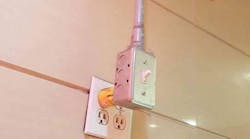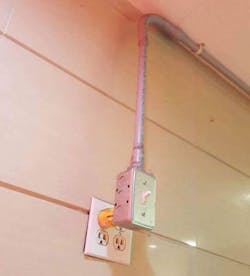How well do you know the Code? Think you can spot violations the original installer either ignored or couldn't identify? Here's your chance to moonlight as an electrical inspector and second-guess someone else's work from the safety of your living room or office. It's your turn to identify the violation.
Hint: A new class of extension cords
Find the Answer
Is that an extension cord made of PVC and EMT? It appears as though this installer could not figure out a way to get the wiring inside the wall or to put an extension box on the double-duplex receptacle enclosure. I must give him credit for ingenuity, however, I am guessing that this assembly was pre-wired and then plugged into the receptacle, and secured to the wall. But only the installer really knows.
There are a few Code violations here including the improper supporting of the switch box. According to Sec. 352.12(B), PVC cannot be used to support boxes. The specific requirements for supporting boxes found in Sec. 314.23(F) will reaffirm the fact that this box installation is incorrect. Using the attachment plug to support the box is not a recognized use for this device, and it violates the requirements of Sec. 110.3(B).
I can only imagine how the installer connected the attachment plug into the wiring inside the box and raceway. Is the metal box connected to the equipment ground wire? Based on the workmanship that is visible I’m concerned about that it isn’t. Metal boxes are required to be grounded and bonded in accordance with Sec. 314.4.
Editor’s note: Brian Brady, an electrical engineer with B Cube in Minneapolis, was kind enough to share this extremely unique installation with us. Thanks Brian!





